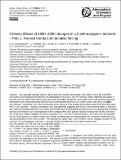| dc.contributor.author | Leibensperger, Eric Michael | |
| dc.contributor.author | Mickley, L. J. | |
| dc.contributor.author | Jacob, Daniel J. | |
| dc.contributor.author | Chen, W. -T. | |
| dc.contributor.author | Seinfeld, J. H. | |
| dc.contributor.author | Seinfeld, J. H. | |
| dc.contributor.author | Adams, P. J. | |
| dc.contributor.author | Streets, D. G. | |
| dc.contributor.author | Kumar, N. | |
| dc.contributor.author | Rind, D. | |
| dc.date.accessioned | 2012-10-18T17:46:34Z | |
| dc.date.available | 2012-10-18T17:46:34Z | |
| dc.date.issued | 2012-04 | |
| dc.date.submitted | 2012-03 | |
| dc.identifier.issn | 1680-7375 | |
| dc.identifier.issn | 1680-7367 | |
| dc.identifier.uri | http://hdl.handle.net/1721.1/74087 | |
| dc.description.abstract | We use the GEOS-Chem chemical transport model combined with the GISS general circulation model to calculate the aerosol direct and indirect (warm cloud) radiative forcings from US anthropogenic sources over the 1950–2050 period, based on historical emission inventories and future projections from the IPCC A1B scenario. The aerosol simulation is evaluated with observed spatial distributions and 1980–2010 trends of aerosol concentrations and wet deposition in the contiguous US. The radiative forcing from US anthropogenic aerosols is strongly localized over the eastern US. We find that it peaked in 1970–1990, with values over the eastern US (east of 100° W) of −2.0 W m[superscript −2] for direct forcing including contributions from sulfate (−2.0 W m[superscript −2]), nitrate (−0.2 W m[superscript −2]), organic carbon (−0.2 W m[superscript −2]), and black carbon (+0.4 W m[superscript −2]). The aerosol indirect effect is of comparable magnitude to the direct forcing. We find that the forcing declined sharply from 1990 to 2010 (by 0.8 W m−2 direct and 1.0 W m[superscript −2] indirect), mainly reflecting decreases in SO[subscript 2] emissions, and project that it will continue declining post-2010 but at a much slower rate since US SO[subscript 2] emissions have already declined by almost 60 % from their peak. This suggests that much of the warming effect of reducing US anthropogenic aerosol sources may have already been realized by 2010, however some additional warming is expected through 2020. The small positive radiative forcing from US BC emissions (+0.3 W m[superscript −2] over the eastern US in 2010) suggests that an emission control strategy focused on BC would have only limited climate benefit. | en_US |
| dc.language.iso | en_US | |
| dc.publisher | Copernicus GmbH | en_US |
| dc.relation.isversionof | http://dx.doi.org/10.5194/acpd-11-24085-2011 | en_US |
| dc.rights | Creative Commons Attribution 3.0 | en_US |
| dc.rights.uri | http://creativecommons.org/licenses/by/3.0/ | en_US |
| dc.source | Copernicus | en_US |
| dc.title | Climatic effects of 1950–2050 changes in US anthropogenic aerosols – Part 1: Aerosol trends and radiative forcing | en_US |
| dc.type | Article | en_US |
| dc.identifier.citation | Leibensperger, E. M. et al. “Climatic Effects of 1950–2050 Changes in US Anthropogenic Aerosols – Part 1: Aerosol Trends and Radiative Forcing.” Atmospheric Chemistry and Physics Discussions 11.8 (2011): 24085–24125. | en_US |
| dc.contributor.department | Massachusetts Institute of Technology. Department of Earth, Atmospheric, and Planetary Sciences | en_US |
| dc.contributor.mitauthor | Leibensperger, Eric Michael | |
| dc.relation.journal | Atmospheric Chemistry and Physics Discussions | en_US |
| dc.eprint.version | Final published version | en_US |
| dc.type.uri | http://purl.org/eprint/type/JournalArticle | en_US |
| eprint.status | http://purl.org/eprint/status/PeerReviewed | en_US |
| dspace.orderedauthors | Leibensperger, E. M.; Mickley, L. J.; Jacob, D. J.; Chen, W.-T.; Seinfeld, J. H.; Nenes, A.; Adams, P. J.; Streets, D. G.; Kumar, N.; Rind, D. | en |
| mit.license | PUBLISHER_CC | en_US |
| mit.metadata.status | Complete | |
